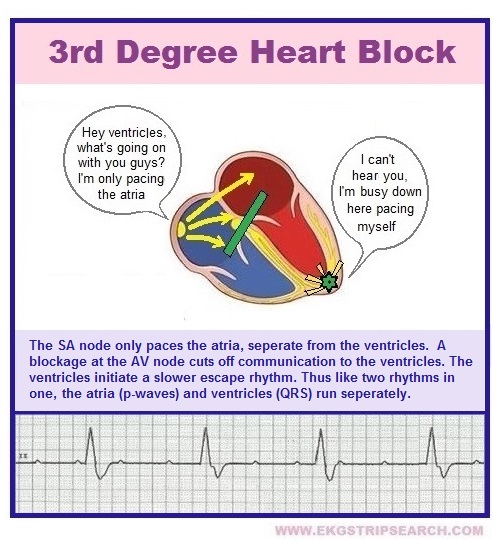Third-degree AV block, also known as complete heart block, is a life threatening cardiac rhythm where
immediate treatment needs to be taken. 3rd degree heart block happens when the impulse from
the SA node is totally blocked at the AV node, and nothing passes through to the ventricles. Because
the impulse is blocked, the ventricles are left all on their own. So the ventricles generate their own
signal through an escape mechanism and take over pacing themselves (known as ventricular escape).
The SA node is still firing away, pacing the top chambers of the heart. The atria contract showing
as P-waves marching out. However, the ventricles are now having to pace independently from the
impulse generated at the SA node (at a much slower rate), causing two independent rhythms in one.
The SA node paces and contracts the atria (seen as P-waves)
The ventricles pace themselves at a slower rate (seen as the QRS intervals)
The P-waves march out evenly (P to P intervals) representing the first rythm
The QRS intervals march out evenly at a slower rate representing the second rhythm, (escape rhythm).
The PR intervals are unequal and are pacing at different rates.
The P-waves have no interaction with the QRS (AV disassociation), and run seperate from each other
AV disassociation
AV disassociation is when the atria and ventricles run seperately. The PR intervals are unequal.
Therefore the ventricular rhythm is maintained by a secondary pacemaker from the ventricles (or the Junction).
The ventricular escape mechanism can occur anywhere from the AV node down through the bundle-branch Purkinje
systemThe junctional pacemaker rate is usually faster (40–80 beats/min), compared with the
peripheral Purkinje network (ventricular) 20–40 beats/min. The lower in the system that the
block is, the worse the prognosis if pacing is not initiated.
Common symptoms of a complete heart block include:
- Fatigue
- Dizziness
- Impaired exercise tolerance
- Chest pain
- syncope
- Confusion
- Dyspnea
- Severe chest pain
- Sudden death
Patients may also exhibit tachypnea or respiratory distress, rales, jugular venous distention,
altered mental status, hypotension, and lethargy; signs of anxiety such as agitation or unease,
diaphoresis, pale or pasty complexion.
Causes
Causes of third degree heart blocks are many. They can include overdoses (even therapeutic doses)
of medicines or drugs, infective processes, myocardial ischemia, myocardial infarctions, CHF,
and electrolyte imbalances.
Important Tele Tip:
You may not always see extra P Waves, (dropped beats) as with 2nd degree blocks.
If you see unequal P-R intervals (AV disassociation), look for P waves to march
out and the QRS to march out independently (see below).

Return to Home Page
|


